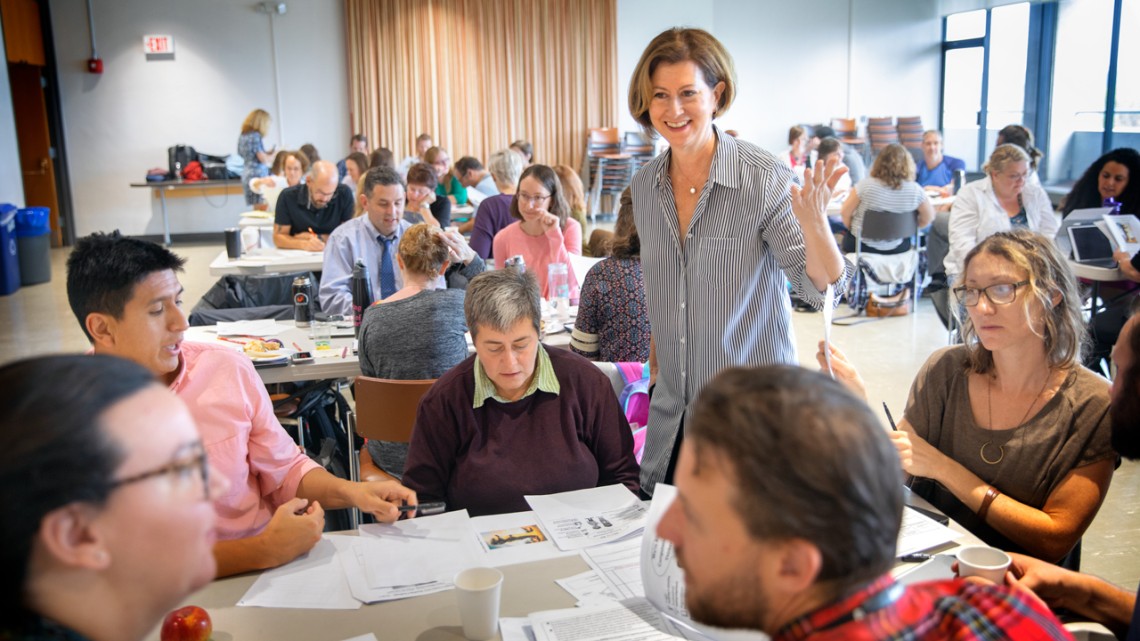
Diane Levitt, senior director of K-12 education at Cornell Tech, led a workshop Sept. 28 on inspiring computational thinking, part of an ongoing relationship between Ithaca-area school districts, Cornell Tech and CSforAll.
Helping teachers weave computational thinking into lessons
By Melanie Lefkowitz
The scientific method is an algorithm. Figuring out what went wrong with a project is a kind of debugging. Breaking a math question into parts is decomposition, and learning history can involve looking for patterns.
“You actually are all already doing some computational thinking without calling it out,” Diane Levitt, senior director of K-12 education at Cornell Tech, told around 60 teachers and administrators from Ithaca and neighboring school districts in a Sept. 28 workshop, “Inspiring a Passion for Computational Thinking,” in Clark Hall. “You can introduce these concepts to your students without even knowing a line of code.”
The event was part of an ongoing relationship between area school districts, Levitt and the CSforAll consortium, in which Cornell Tech is a partner. In the Sept. 28 workshop, educators examined computational-thinking exercises Levitt and her team recently developed for P.S. 86 in the Bronx. The exercises ask second-graders to find patterns in images, break pictures down into their components or work collaboratively to sort a list of words.
These kinds of challenges incorporate computational learning into existing educational goals, which not only teaches computer skills but could potentially boost achievement in other areas, like language arts and math, Levitt said.
“Part of the problem is there’s only so much time in the day, so to have a standalone lesson on computer science means taking time from something else,” she said. “The research question is, can we fully integrate computational thinking and computing so it amplifies the existing standards, while also teaching the computer science standards? That’s our goal.”
CSforAll is also partnering with the Ithaca, Groton, North Salem and Brewster school districts, as well as the Tompkins-Seneca-Tioga Board of Cooperative Educational Services (TST-BOCES) and Putnam/Northern Westchester BOCES on a two-year, National Science Foundation-funded project to integrate computer science into their districtwide curricula. The Sept. 28 event was focused on helping teachers make immediate progress with computational thinking at the classroom level.
“This opportunity is great, because it’s bringing a large group of classroom teachers and helping them understand the importance of computer science in their students’ lives,” said Zachary Lind, chief information officer for the Ithaca City School District. “Whether we like it or not, our world is a digital world, and if we don’t show our students how to be active and empowered in their world, they’ll become passive users of technology who aren’t able to direct and actively participate in it.”
Levitt recommended teachers take advantage of tasks students are already performing to familiarize them with computational-thinking concepts, such as logic, evaluation, abstraction and algorithm, as well as computational approaches like tinkering, creating, debugging and collaborating.
“All of these attributes and habits are things we believe are instrinsic to computational thinking and computing,” she told the educators.
Beth Dryer, the regional coordinator of curriculum and professional development at TST-BOCES, said she appreciated learning how to apply computational thinking to various educational areas, rather than treating it as an isolated topic.
“I see a lot of 21st-century readiness skills built into this, like collaboration, problem-solving and critical thinking,” Dryer said. “I can see the power of using this approach.”
Media Contact
Get Cornell news delivered right to your inbox.
Subscribe

